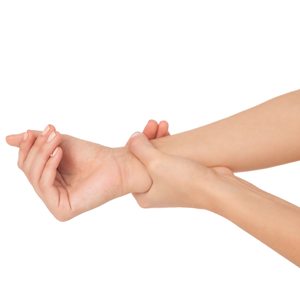Hand
Carpal Tunnel

Carpal Tunnel Syndrome is the most common nerve compression syndrome in the upper extremity. When a nerve is compressed, the symptoms often lead to problems directing patients to their physicians. Symptoms include numbness in the thumb, index, long, and half of the ring fingers. This numbness can be intermittent or constant and is generally related to the amount of time the nerve has been compressed. Longer times usually means more constant numbness.
Early carpal tunnel syndrome (mild) can be treated conservatively. This involves Occupational Therapy (OT) which often improves the symptoms. Splinting the wrist or steroid injections are other non-surgical treatments that can be useful. For more advanced carpal tunnel syndrome (moderate to severe), surgical intervention is required to release the compression on the nerve. This procedure is very common at Reynolds Plastic Surgery. Schedule a consultation to discuss the specifics of your condition, and to explore the option of this surgical procedure to improve your carpal tunnel complications.
Trigger Finger
Trigger Finger is a condition where the finger locks at the first joint of the finger. The condition can be mild, moderate, or severe. The mild form is more of a nuisance and often requires no treatment. In severe forms, a trigger finger is painfully locked. One or multiple finger can be involved. Conservative treatment with steroid injection can be used in mild forms of trigger fingers. Surgical release is used for more severe forms.
Trigger finger is the result of a tendon passing through a tunnel of ligaments –also called the pulley system. This pulley system holds the tendon tightly against the bones to prevent bow-stringing of the tendon. If bow-stringing exists, then the finger is unable to flex fully. Schedule a consultation to discuss the specifics of your trigger finger condition, and to explore the option of this surgical procedure to remedy your complications.
De Quervain’s Disease
De Quervain’s Disease is a common disease of a tendon in the wrist. It is located on the thumb side of the wrist and it is painful to move the wrist or thumb in certain directions. The direction of wrist movement, which is painful, is the movement of the wrist from the thumb side to the little finger side. The thumb will hurt when it is moved upwards (hitchhikers position) to a flexed position. The test physicians used to help with the diagnosis is called the Finklestein Test. This is done by placing the thumb into a closed fist and moving the wrist from the thumb side to the little finger side. This test pulls the tendons which travel through the tendon sheath involved with de Quervain’s Disease of the Tendon Sheaths.
When surgery is determined to be the best treatment plan for de Quervain’s Disease, then the operating room is scheduled. The procedure to release the tendon sheath is done most safely in an operating room. The procedure requires a small amount of time to do and the post-operative course is usually uneventful. Sutures are removed within a week. It is expected that the pain associated with de Quervain’s Disease will be gone after release of the tendon sheath.
Schedule a consultation to discuss the specifics of your condition, and to explore the option of a surgical procedure to better your de Quervain’s Disease complications.
Fracture
Fractures of the hands (metacarpal) and fingers (phalanges) are the most common fractures of the skeletal system. Most of these fractures are functionally stable before or after surgery and they often do well with splinting. Reynolds Plastic Surgery is very familiar with the intricacies of fractured hand surgery and handles many cases every year for a variety of accidents and injuries.
The determination of when to operate or not depends upon many factors. In injuries where there is an open fracture in which the bone is protruding through the skin, or the fracture involves a joint surface or there is loss of the bone, or the fracture is associated other injuries like tendons, or in nerve and blood vessel injuries an operating room procedure will likely be required. However, a single fracture of a metacarpal or phalangeal bone which is not displaced or rotated and is in good alignment can often be treated with casting or protective splinting.
Nerve Repairs
Peripheral nerves can be injured in any number of ways. Lacerations and crushing injuries are some of the more common injuries especially on fingers and hands. Like all injuries, the mechanism of the injury must be understood. This is usually determined at the time of the History and Physical Examination (H&P).
The peripheral system injuries are treated by surgeons trained in those areas through which the peripheral nerves travel. Schedule a consultation with Dr. Reynolds to explore the options of correcting your nerve issues with plastic surgery.
Tendon Repairs
Tendon injuries are usually associated with some sort of trauma. The trauma can be from a crush, a cut, an avulsion, a fracture or any number of injuries. Multiple tendon injuries are also possible depending upon the seriousness of the injury. Regardless, of the number of tendon injured, understanding how tendons are repaired allows the restoration of function. It is not at all uncommon that a patient with an isolated tendon injury will say something like “I never realized how much I used my thumb!”
After a tendon is repaired, tendon healing begins. There is usually limited movement or in some cases no movement of the tendon. The circumstances will determine if limited movement or no movement will be required. The operating surgeon will be making that decision. Schedule a consultation with Dr. Reynolds to see if a surgical procedure is the appropriate choice to better your complications.
